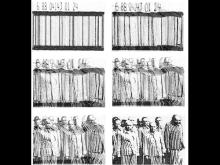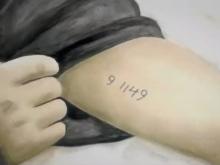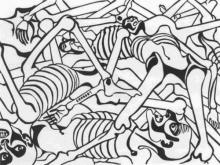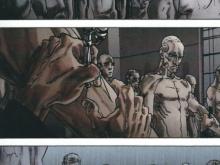Wolfenstein: The New Order
Wolfenstein: The New Order, Machine Games 2014
The action-adventure first-person shooter video game “Wolfenstein: The New Order” is set in an alternative history universe with the Nazis still in power in 1960. During a secret infiltration mission, the main protagonist and war veteran, William "B.J." Blazkowicz, is captured for use as slave labour and gets an inmate number tattooed on his right arm (not on the left, as in Auschwitz) by a machine. The game player actually has to comply with a non player character’s order to “place your right arm in the machine…” and move his avatar to the tattoo apparatus. BJ’s inner voice comments, "You’re a thing, like cattle in this place…” The number then tattooed on his arm consists of the digits 04,15,15,13. Assigned to the letters of the alphabet, they represent the word D-O-O-M. While “doom” anticipates the terror the protagonist awaits in the game, it also refers backwards in non-diegetic time to another first-person shooter, "Doom" which was perhaps the most famous spin-off of the Wolfenstein-series in the 1990s. Designer John Romero himself once suggested the protagonists of "Doom" and "Wolfenstein" have the same lineage. The aspect of itemizing B.J. not only as slave labour for the Nazis but also as an item of the software developer adds to the complex web of relations the Number Tattoo evokes here. Later in the game, on his way back to the free world, B.J. removes the tattoo by cutting it out with a knife. The tattoo sequence in the game focuses on the moment of literal itemization. When the game switches from video sequence showing the tattooing back to the game itself, the protagonist first looks at his new tattoo, therefore, repeating the gesture of showing the Number Tattoo, if only to himself. The overall insignificance of the number for the game itself points to a largely symbolic function of the tattoo for the chapter in camp Belica that is supposed to link the game back to the historical concentration camp system of the National Socialists. The concentration camp is not only evoked by the Number Tattoo but also by explicitly referring to the “selection” of the new inmates. The gate of camp Belica that reminds of the gate in Auschwitz, the location in East Europe (Croatia), the segregation of the camp into “blocks” and the crematorium, are further examples of these references. However, even though the backstory relates to the Jewish genocide, the removal of the tattoo does not point to any kind of survivor status the number awards for the protagonist. This indirect use could be called allusive or a triggering illustration.





